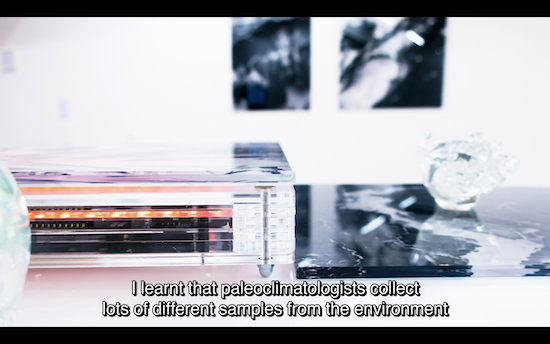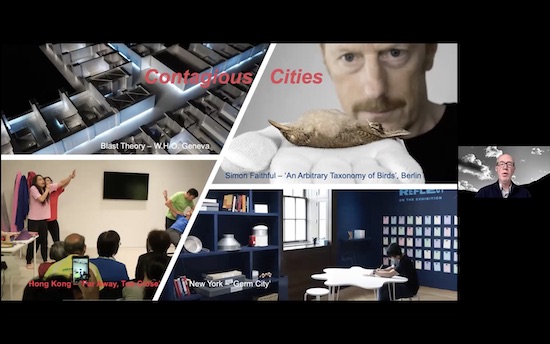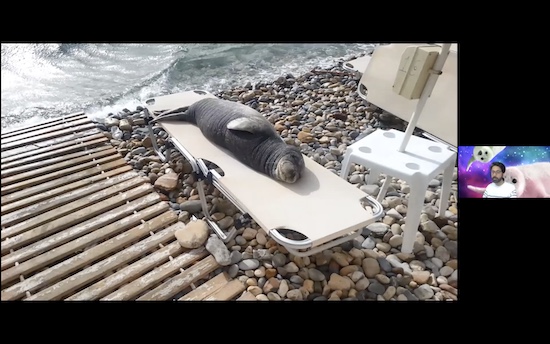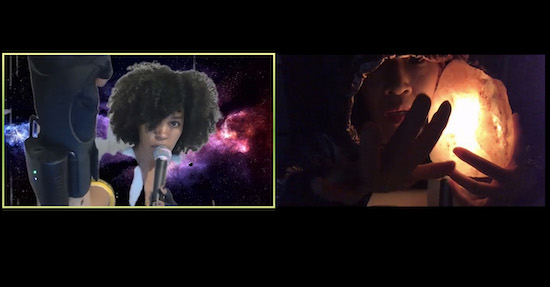In the Mesozoic era Antarctica split company with Australia. This final break with the once-supercontinent Pangea created isolated conditions underpinned by the West Wind Drift. If you casually look at this continent on YouTube you fall into a wormhole of references to Dragon Skin Ice and Katabatic storms.
In this present Antarctica feels like the ultimate metaphor for Tiers 3, 4 and beyond. Yet we are linked beyond global warming, holes in the ozone layer and the weather. The Antarctica Treaty remains a ratification between nations that requires the continent to remain a demilitarised zone, and a site for scientific cooperation.
For independent curator and researcher Linda Rocco these subjects brought to focus a programme of events under the rubric Celsius at Mansions of the Future in Lincoln. An opportunity to explore how the arts could intersect with STEM with focus and rigour, to create a space for performance, debate and exchange that is still accessible online. Cathy Wade spoke to Rocco to explore the diverse ideas and subjects the programme connects.
The Celsius programme encourages consideration of our human relationship with Antarctica. It’s a geography we experience from afar, somewhere that’s beyond our agency and outside our grasp. How did your thinking around this landmass evolve in terms of artists’ works and projects?
2020 celebrates two hundred years since the discovery of Antarctica, and give us a chance to discuss global issues which relate to Antarctica in various degrees. The fact that the Antarctic Treaty is going to be reconsidered in 2048 raises huge socio-political and economic questions regarding the future of this continent. It’s a globally shared set of concerns around how to preserve such precious landmass, containing the world’s largest store of freshwater, and massive reserves of oil and gas.
I remember reading somewhere that Trump was considering setting up travel agencies to favour tourism in Antarctica, which raises huge issues related to the preservation of the continent and its limited resources versus exploitation for commercial purposes. At the bottom of the Antarctic, there’s a huge archive of seeds and specimens that have been collected over the years, to represent our history and inform future researchers. It’s therefore pivotal that we discuss issues of cooperation amongst nations, property, shared values and knowledge.
The UK Antarctic Heritage Trust are very keen and active for artists/explorers to go to Antarctica to conduct research and bring new perspectives to the debate. To make it relevant in the present day, raise awareness, and to discuss questions which belong to a supranational discourse which link us all as human beings.

There are critical dialogues that exist between Lucy and Jorge’s Antarctica World Passport and Josefina Nelimarkka’s work on atmospheric phenomena Kairos². I appreciated how this researching of the un-representable was part of the discussions throughout the Celsius programme. How do we engage with subjects that are so unknown and abstract to our experience?
This question relates to my PhD research at the RCA funded by LAHP, looking into establishing methodologies for cross-disciplinary collaboration between the arts and STEM. Beyond that often-tokenistic way that STEM or policymakers use art as an add-on, entertaining feature. I’m looking at the Artists Placement Group (APG) and Fluxus, groups who were experimenting back in the 60s and 70s. To really look at the mindset of the artist, this incidental person, who can bring moral and ethical questions and concerns to a STEM debate.
There are more and more artists working at the intersection of arts and STEM nowadays, often in a borderline position between socially-engaged practices and scientific research – Josefina, for example. She’s fully involved in developing research with scientists to inform her practice and understanding of the world. It’s great to see these interchanges and collaborations which really magnify the invisible, making things more accessible to the general public. Focusing on the work of the scientist and bringing it outside the laboratory, subject to the opinion of less specialised audiences is extremely important.

If we consider histories of how artists have practised within the workplace, APG demonstrates a knowledge of what happens when you have someone’s thinking that isn’t contained or directed by their employer.
Yeah totally, it’s incredible what they were doing back in the 60s and 70s. It’s something that could be applied today as well, beyond the neoliberal ways of working in these domains. Often the artist comes in as a designer or decorator, and we are not really focusing on what the artist can actually bring to the table – which often is a perspective different from anyone else. It’s not utilitarian or decorative; it’s a whole forma mentis.
There’s something really important you’re touching on here, that too often within museums or scientific institutions the artist is brought in to illustrate or demonstrate; not to practice. Being able to look at what happens with embedded artistic research in-depth is embedded throughout the Celsius programme.
Thank you. Yes, there’s always a hierarchy of specialisms, with the artist often at the bottom. Artists have a different kind of expertise, insights and concerns, and a whole set of perspectives which I believe is essential in these ever so divided times. I advocate for the artist’s role to be reconsidered and to finally rebalance the predominance of the STEM agenda in current educational and policy discourses.

I’m thinking of Prem Gill’s (Polar Prem) articulation of being conscious about the space you’re engaging with. In the Celsius symposium, he advocated for ways to create open access for underrepresented communities in polar scientific research.
In science and STEM its even worse than in the arts in terms of diversity. Scientists and technologists are predominantly white and male and it’s hard to find ethnic minorities or disabled people in professorship positions. Prem is an incredible scientist who does very serious work in the field of Polar research but at the same time he’s also very creative. He brought his work Seals from Space into the Celsius symposium as a game. He is adopting contemporary tools like grime music to increase interest within younger publics. I was really impressed because you need to be relevant, creative, fun and engaging to get kids into science, and that’s exactly what he is doing. Otherwise it’s very much this old idea of the scientist in the lab alone, where it can actually be a much more playful, collaborative and fun realm as well.
Prem’s recognition of what you can do with satellite footage, that this apparatus used could be opened up for collaboration and co-research. So, thinking about the Antarctic and the global impacts on weather systems, these impossible to conceptualise aspects of global warming. With Aidan Moesby, these subjects become internal weather and experience.
Aidan brings a more intimate personal perspective to the program. He’s been working with the weather and mental health for a long time. His work is so relevant right now, not only to Antarctica and the weather conditions, but the effect of them on human beings, our psyche and persona. He stressed how Antarctica also means isolation. Antarctica is rigidity, stiffness, solitude.
The impact of the weather on ourselves is also an interesting research topic. I often find myself talking about the weather, which is funny because it’s so trivial. To pair Aidan in conversation with Professor Thomas Dixon I was expecting all kinds of emotions and feelings. Aidan’s performance to be experienced online is very intense and I felt it needed an interaction to ease it down. If you see the performance live it’s obviously different to seeing it on the computer, where its impact can be triggering. Aidan and Thomas’ conversation gave an in-depth overview on the topic. Working with professors like Thomas Dixon doesn’t happen every day. Thanks to Mansions of the Future I had the chance to connect people and propose insightful exchanges.

Often sociologists talk about mood, environment and space, invisible aspects of life that impact us every day. Aidan talked about that choice to talk to a supermarket cashier rather than use the self-checkout machine, his acknowledgement of the global energy needed to send a tweet and what it is to lose time.
It’s a very effective piece, his monologue. A lot of people can relate with it, which I think this is why this works. It’s easy to empathise with, and for different reasons according to the person watching. How the weather is used really to link with someone, as small talk. This device “Oh the weather” that you use to introduce yourself and connect with someone, just to exchange some small words can although be very important for our social dimension.
For the Celsius programme you’ve had audiences connect digitally with events that would have been live in Lincoln, with Mansions of the Future. There are opportunities to really think about what constitutes isolation through this event – especially in this present time – that is wide-ranging and has several different access points. Has this programme built a community?
I visited Lincoln before Covid, when the programme was supposed to happen there, and I really got the feeling of the important work that Mansions was doing for the community, for the people in Lincoln. There were more than sixty groups of people of all kinds and different abilities coming in and using their building for cultural or creative purposes. This real engagement is what’s really important, to connect people and give them a space for expression. And the fact that the programme became digital allowed us to get international people on board and widen the audience. Which was good for the program, as we could add different layers of perspectives and experiences. And the conversation will continue, my PhD research has just began and I have all the stamina to pursue this with as many diverse and committed people as possible.
This is the legacy year for Mansions of the Future, they retain an extensive archive of projects on their website and will run an Innovation in Engagement conference in Spring 2021 with the University of Lincoln


